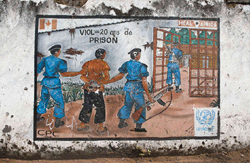DRC: Analysis: Rethinking Sexual Violence in DRC
A survey conducted by American scientists among the population of eastern Congo challenges the traditional image of sexual violence as perpetrated by men against women – but NGOs assisting rape survivors urge caution in interpreting the study's gender findings.
According to the paper published in the Journal of the American Medical Association (JAMA) on 4 August, researchers went door-to-door to interview nearly 1,000 villagers in North and South Kivu and Ituri last March. Unlike studies that focus on identified survivors of sexual violence, this survey intended to assess the impact of the problem on the wider population of eastern Congo.

The results confirm the widespread use of sexual violence against civilians – including males – since war broke out in the area in the mid-1990s. Nearly 40 percent of women and more than 23 percent of men surveyed reported having suffered sexual assault, mostly rape.
This study was the first to ask survivors about the gender of their attacker - 41 percent of female and 10 percent of male survivors of conflict-related sexual violence said the perpetrator was a woman.
The survey also found high levels of depression and other types of mental illness among survivors of sexual assault. “If you have suffered sexual violence, your risk of mental health disorders is about twice the population's rate,” said study author Lynn Lawry, a humanitarian expert at the International Health Division of the US Department of Defense.
The survey was co-funded by the US military's Africa Command (Africom), the NGO International Medical Corps and Canada's McGill University.
Not gender-specific
“We can no longer think that sexual violence is just violence against women perpetrated by men, it is about everybody,” said Lawry. She added that action to combat sexual violence “must now include men and boys”, starting with UN policy documents which have until now focused on female survivors.
''Nearly 40 percent of women and more than 23 percent of men surveyed reported having suffered sexual assault, mostly rape''
“When we are looking at how we are going to address communities, we need to talk to female perpetrators as well as male perpetrators, and we have to include male survivors in our mental health clinics in order to address their issues, which may be very different from female survivors,” she said.
Lawry's call for the inclusion of male survivors echoes that by Maria Eriksson Baaz and Maria Stern of Sweden's Nordic Africa Institute, who denounced “the invisibility of men and boys as victims of sexual and gender-based violence” in a paper published in May. “In terms of sexual violence, the highest percentage of reported male victims of rape is 10 percent, but the real levels are probably higher (due to the extreme stigma attached to sexual abuse of males),” Baaz and Stern wrote.
Men in need
However, Denise Siwatula, a programme officer at the Women's Synergy for the Victims of Sexual Violence, a Congolese NGO based in the Kivus, said she had not witnessed such high numbers of sexual assault by women.
“Statistics on female rape perpetrators are very low,” said. But she confirmed that many men were victims of sexual violence and that their assistance needs were different to those of women, especially for psychological help, which she said was generally under-funded. “Our psycho-social service tries to help the victims rebuild themselves, but it is not very efficient because we need a lot more resources to rehabilitate the victims psychologically, socially and mentally,” she said.
Ciarán Donnelly, who heads the US-based NGO International Rescue Committee (IRC) in DRC, said Lawry's findings on “the high level of sexual violence in eastern Congo and the unacceptable impact on the civilian population, in particular women and girls, and the need for an increased focus on health and in particular mental health” were consistent with his organization's observations in-country.
However, Donnelly was surprised by the gender findings. “There are some issues that need to be investigated further. Dr Lawry urges a reformulation of policy and a refocusing of aid efforts in the area of sexual violence based on the findings of the survey; I think we would like to caution against being too precipitous in that area,” he said.
He added the IRC would examine the data and definitions from the study in detail to understand the breakdown in types of sexual violence surveyed, which ranges from being forced to undress to gang rape.
He added that it was unclear whether women kidnapped by armed groups and forced to perform sexual acts on others were listed among the perpetrators of conflict-related sexual violence.
Data credibility
One point of debate will be the representativeness of the sample surveyed. Interviewers had to stay clear of active combat zones in March and replace some randomly selected villages with others. The study states that “the findings may be interpreted with caution to represent the more than five million people in the three areas surveyed” and Lawry is confident that security issues have not undermined the credibility of data collection.
Yet some critics point to the fact that while the researchers had to avoid areas where the DRC armed forces (FARDC) were active, the same FARDC are not listed among the reported perpetrators of sexual violence. “Among the women that we are assisting, some were raped by armed groups and others were raped by soldiers of our own Congolese army,” said Siwatula.
PeaceWomen.org is a project of the Women's International League of Peace and Freedom, United Nations Office.
Fair Use Notice: This page contains copyrighted material the use of which has not been specifically authorized by the copyright owner.
PeaceWomen.org distributes this material without profit to those who have expressed a prior interest in receiving the included information for research and educational purposes.
We believe this constitutes a fair use of any such copyrighted material as provided for in 17 U.S.C § 107.
